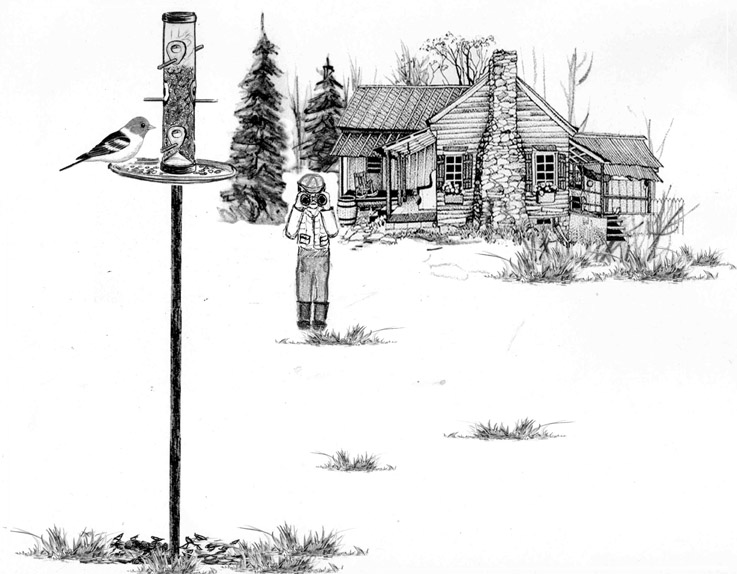
Dear Bird Folks,
Three weeks ago a strange bird showed up in my yard. After looking through my bird book it appears I had a Western Tanager, which is a rare bird for our area. Should I have reported it to someone, and if so, who?
– Fran, Rye, NH
This is a tough one, Fran,
Rare birds are the lifeblood of birders. The thought of seeing something different is what gets us up and out every day. Also, keeping track of rare birds helps researchers gain valuable information about population trends. A few years ago (okay, maybe thirty-five years ago, which has suddenly become “a few years” to me), we got excited when a Red-bellied Woodpecker was spotted on the Cape. But as red-belly sightings continued to come in, it became obvious that this once rare bird was quickly becoming established in our area. That’s the upside of reporting a rare bird. However, there is also a downside…but I’ll get to that later. Right now let’s just focus on what to do if you see something unusual.
Step one: Take a deep breath and don’t jump to conclusions. Just because you’ve never seen a bird before doesn’t mean it’s rare, or even that your identification is correct. On one of my first visits to Florida’s Sanibel Island, I stopped my car to look at a group of Roseate Spoonbills. Two minutes later, another car also stopped. The driver got out and walked over to the viewing area. Upon seeing the spoonbills the guy became super excited and ran back to his friends, mistakenly screaming, “Whooping Cranes! Whooping Cranes! Everyone get out and come see the Whooping Cranes!” To this day I don’t know if anyone ever corrected him, but I sure didn’t. The scene was too funny to ruin. (Avian accuracy is important, but not when it gets in the way of comedy.) Speaking of funny, a group of spoonbills is called a “bowl.” Really. Who says birders don’t have a sense of humor? (Probably everybody.)
Whenever you see a peculiar bird, head right for the nearest camera or phone with a camera. Even a bad photo is helpful (and would certainly be good enough to differentiate between a spoonbill and a Whooping Crane). If you don’t have a camera, you’ll have to do it old school and use pencil and paper. (Remember those?) Write down as much info as you can, but don’t necessarily focus just on coloring. Instead, note bill size and shape (thick, thin, etc.), body length and structure (thick, thin, etc.), and most importantly, behavior. You can eliminate lots of birds simply by studying the bird’s actions. For example, a bird scratching on the ground isn’t likely to be a warbler, or a bird eating seed from a feeder isn’t going to be a swallow or a flycatcher…and Whooping Cranes don’t act like spoonbills.
Next, show your photo or handwritten notes to a birder friend. A word of caution: Typically it’s a bad idea to seek help from a spouse, particularly if he or she is a non-birder. At least once a week a couple will come in and tell me about a mystery bird. This seems harmless, but invariably their descriptions contradict each other. After about ten minutes of trying to decipher their conflicting clues and opinions, I give up. At this point the bickering couple angrily leaves, presumably to find a divorce lawyer.
But no matter whom you contact about a strange bird, make sure you do it right away. Many times people get me all excited about an unusual yard bird, only to then tell me that the bird was seen “three weeks ago.” (Sound familiar, Fran?) Odd birds may remain in an area for months, but they may also leave after only a day or two. Getting someone to verify your sighting ASAP will save you a lot of second-guessing. If you don’t have a birder friend, call a local nature center or Audubon Society (which in your case is NH Audubon in Concord). Before you tell anyone where you live, however, you should set some ground rules first. What kind of ground rules? It depends upon how sociable you are. I’ll explain.
Ninety-percent of the time perceived “rare” birds turn out to only be rare to the person who has never seen it before, and likely won’t cause much of an uproar in the birding community. But occasionally a bird is truly special and will undoubtedly attract birders from all over. An influx of visitors can be a problem, especially if you are the hermit type or live in a congested neighborhood. Although, if you don’t mind a stream of bird freaks coming to your yard, then by all means let the news be spread. Birders really appreciate folks who generously share their yards…and birds. For example, I know of several homeowners who set out feeders and encourage birders to stop and watch their birds. On the other hand, there’s a local woman (I won’t say where) whose property abuts a popular birding destination. She too likes birds and has several feeders in her yard. Ironically, this same woman bitterly complains when birders turn their binoculars towards her feeders, which I don’t get. It’s like putting up fancy Christmas decorations and then being upset when folks stop and enjoy them. Oh well, yin and yang.
Speaking of Christmas, I think you should ask Santa for a camera, Fran, so you can document your unusual birds. And while you are at it, ask for a new phone and have my number on speed dial. That way, it won’t take you three weeks to tell me about your Western Tanager next time. I’m just sayin